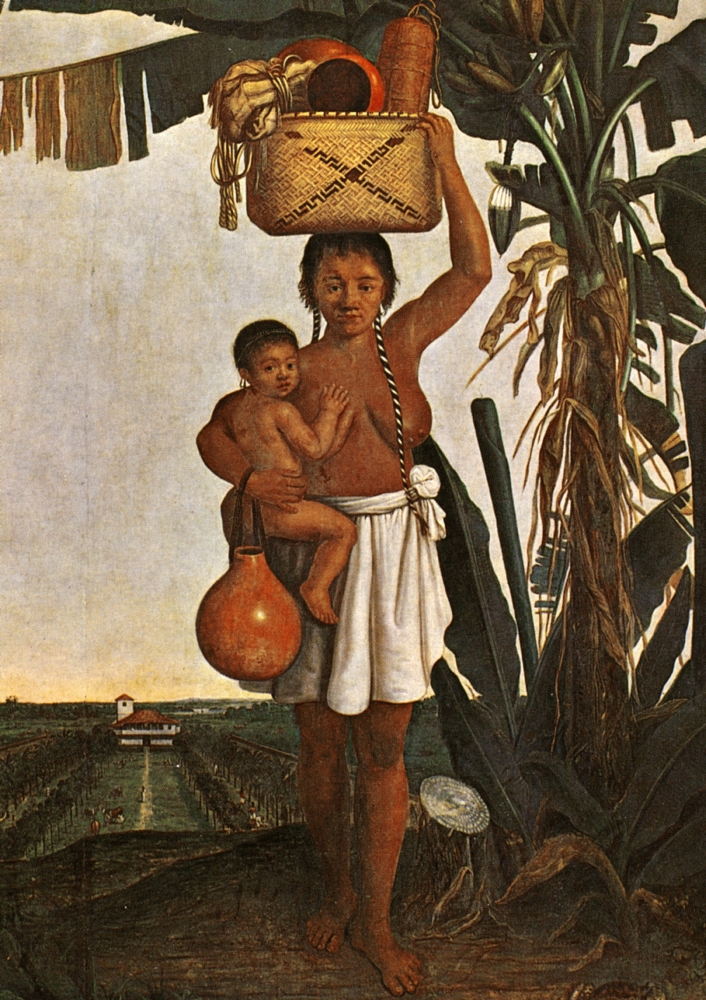The Tupi-Guardi were the people living in Brazil when Pedro Álvares Cabral of Portugal became the first European to visit in 1500. They occupied the rainforest and plains of a vast area ranging from the Amazon to the Rio de la Plata, and from the foothills of the Andes to the Atlantic Ocean (Clement et al., 2015).
Food and diet
The staple of the Tupi was cassava, the bitter variety. Other important root crops were cará (Dioscorea spp.), mangara and taioba (Xanthosoma spp.), jacatupé (Pachyrhysus bulbosus), and sweet potatoes. Other important crops were pumpkins, pepper, pineapple, beans and peanuts. Sweet cassava and maize were grown for the brewing of a beer called cauim.
Cassava was left in the ground for two years or more before harvest or preserved for even longer periods in the form of smoked, and toasted cakes. Lower yielding sweet manioc was cultivated in amended soils near dwellings and/or intercropped with maize.
The Tupi were also fisherman plying both fresh and salt waters and consuming all that was edible including fish, crabs, oysters, mussels, cockles, conchs and shrimp. The Tupi used hooks and lines, but also fished using barbed arrows, poisons, nets and weirs, and drove fish into shallows with sticks. The Tupi preserved fish by barbequing and grinding them into a kind of meal.
The Tupi also ate any mammals they could catch including marmosets, monkeys, deer, sloths and peccaries, agoutis, armadillos, anteaters, and felines, plus capibaras, tapirs, pacas, and otters. They also ate rats, whose hunting was carried out by small children, as well as amphibians and reptiles (including turtles, crocodiles, and snakes). In addition, (ming leaf-cutting ants, of the genus Atta, provided several weeks of feasting each year to many Tupi.
Culture and land use
The Tupi lived-in large villages organized in regional chiefdoms commanded by political leaders (caciques) and shamans (pajes). A semi-sedentary agrarian village was the basic unit of Tupi social and political organization. Composed of four to eight communal malocas (lodges), sixteenth century Tupi villages varied greatly in size and population, ranging from around 100 to over 1,000 inhabitants. Tupi villages were subject to constant fragmentation and regeneration due to soil exhaustion, scarcity of game or fish, political factionalism, and the emergence of a new charismatic new leader.
Eco-geography and agricultural practices
The Tupi economy was heavily based on slash-and-burn cultivation (Dean, 1984). It was carried out in patches of forest which had been cut and burned in plots ranging from 0.5 to 2 ha. These plots were abandoned only after 2 to 4 years when the soil fertility diminished, and “weeds” overtook the patches. Unlike the Maya they simply abandoned their plots rather than managing the successional flora. When the forest had regenerated in 20 to 30 years, the patch might be cut, burned, and planted once again.
Bibliography:
Clement, C.R., Denevan, W.M., Heckenberger, M.J., Junqueira, A.B., Neves, E.G., Teixeira, W.G. and Woods, W.I. (2015) The domestication of Amazonia before European conquest. Proc. R. Soc. B 282: 20150813
Dean, W. (1984). Indigenous populations of the São Paulo-Rio de Janeiro coast: trade, aldeamento, slavery and extinction. Revista de História, (117), 3-25.
Hancock, J. F. (2022) World agriculture before and after 1492: The legacy of the Columbian Exchange. Springer Scientific.
Illustration: Tupi woman and child. Albert Eckhout (1610 – 1666). National Museum of Denmark.
